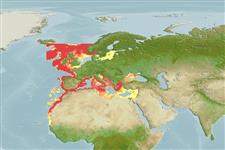Elasmobranchii (sharks and rays) >
Carcharhiniformes (Ground sharks) >
Pentanchidae (Deepwater catsharks)
Etymology: Galeus: galeos, a small shark or dogfish according to Aristotle and others (See ETYFish); melastomus: melas (Gr.), black; stoma (Gr.), mouth, referring to color inside of mouth (common in congeners but quickly lost after preservation) (See ETYFish).
More on author: Rafinesque.
Environment: milieu / climate zone / depth range / distribution range
Ecology
Marine; demersal; depth range 55 - 1873 m (Ref. 55744), usually 150 - 1200 m (Ref. 35388). Deep-water; 64°N - 12°N, 19°W - 37°E
Northeast Atlantic: Faeroe Islands and Trondheim, Norway southward to Senegal. Mediterranean Sea.
Length at first maturity / Size / Weight / Age
Maturity: Lm 64.7, range 56 - ? cm
Max length : 75.0 cm TL male/unsexed; (Ref. 40637); 90.0 cm TL (female); common length : 50.0 cm TL male/unsexed; (Ref. ); max. published weight: 1.4 kg (Ref. 40637)
Depth range is reported at 55m-1200m in Ref. 9996. Found on the outer continental shelves and upper slopes. Feeds mainly on bottom invertebrates, including shrimps and cephalopods, but also on small pelagic bony fishes (lanternfishes) and other small elasmobranchs. Oviparous, with up to 13 eggs present in the oviducts at one time. Individuals from the Ionian Sea apparently reproduces from end of February to September and eggs are laid between 200 and 600 meters (Ref. 87978). Utilized fresh and dried-salted for human consumption, and for leather.
Oviparous, embryos feed solely on yolk (Ref. 50449).
Compagno, L.J.V., 1984. FAO Species Catalogue. Vol. 4. Sharks of the world. An annotated and illustrated catalogue of shark species known to date. Part 2 - Carcharhiniformes. FAO Fish. Synop. 125(4/2):251-655. Rome: FAO. (Ref. 244)
IUCN Red List Status (Ref. 130435: Version 2024-1)
Threat to humans
Harmless
Human uses
Fisheries: minor commercial
Tools
Special reports
Download XML
Internet sources
Estimates based on models
Preferred temperature (Ref.
123201): 4.4 - 14.4, mean 10.3 °C (based on 708 cells).
Phylogenetic diversity index (Ref.
82804): PD
50 = 0.5000 [Uniqueness, from 0.5 = low to 2.0 = high].
Bayesian length-weight: a=0.00269 (0.00227 - 0.00320), b=3.01 (2.96 - 3.06), in cm total length, based on LWR estimates for this species (Ref.
93245).
Trophic level (Ref.
69278): 4.2 ±0.3 se; based on diet studies.
Generation time: 2.6 ( na - na) years. Estimated as median ln(3)/K based on 1
growth studies.
Resilience (Ref.
120179): Low, minimum population doubling time 4.5 - 14 years (Fec assumed to be <100).
Fishing Vulnerability (Ref.
59153): Moderate vulnerability (35 of 100).
Climate Vulnerability (Ref.
125649): Low to moderate vulnerability (33 of 100).
Nutrients (Ref.
124155): Calcium = 8.06 [1.47, 47.91] mg/100g; Iron = 0.295 [0.068, 1.009] mg/100g; Protein = 17.4 [14.2, 20.4] %; Omega3 = 0.236 [0.093, 0.596] g/100g; Selenium = 9.89 [3.48, 29.10] μg/100g; VitaminA = 8.26 [1.72, 37.11] μg/100g; Zinc = 0.332 [0.159, 0.622] mg/100g (wet weight); based on
nutrient studies.
